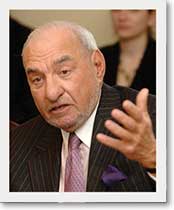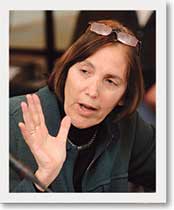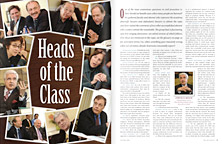Heads of the Class
One of the most contentious questions in civil procedure is: How should we handle cases when many people are harmed? We gathered faculty and alumni who represent the academy, plaintiffs’ lawyers and defendants’ lawyers to debate the topic, and later added the comments of two other accomplished alumni who couldn’t attend the roundtable. The group had a fascinating and free-ranging discussion—an edited version of which follows. (For those not immersed in this topic, see the glossary on page 43 for asterisked terms.) So, when something goes massively wrong, what sort of redress should Americans reasonably expect?
Printer Friendly Version Arthur Miller (AM), moderator, Visiting Professor of Law; Bruce Bromley Professor of Law, Harvard Law School: Probably the most dramatic current event in class actions is the enactment of the federal Class Action Fairness Act (CAFA)* of 2005.
Arthur Miller (AM), moderator, Visiting Professor of Law; Bruce Bromley Professor of Law, Harvard Law School: Probably the most dramatic current event in class actions is the enactment of the federal Class Action Fairness Act (CAFA)* of 2005.
Let me start by asking the practitioners in the room whether they see any difference yet?
 Steven Bennett ’84 (SB), Partner, Jones Day: It’s too early to tell. But the problem of forum shopping and a concentration of nationwide class actions in certain state courts may be ameliorated.
Steven Bennett ’84 (SB), Partner, Jones Day: It’s too early to tell. But the problem of forum shopping and a concentration of nationwide class actions in certain state courts may be ameliorated.
AM: Evan, do you predict a diminution in the number of class actions being instituted?
 Evan Chesler (EC) ’75, Deputy Presiding Partner, Cravath, Swain & Moore: I believe it will have little or no effect because there are a lot of smart plaintiff lawyers who will not be deterred. While it may affect venue, it will not affect volume.
Evan Chesler (EC) ’75, Deputy Presiding Partner, Cravath, Swain & Moore: I believe it will have little or no effect because there are a lot of smart plaintiff lawyers who will not be deterred. While it may affect venue, it will not affect volume.
 Mel Weiss (MW) ’59, Senior and Founding Partner, Milberg Weiss Bershad & Schulman: As a lot of other tort reform efforts have proven, there may be unintended consequences that may be more favorable to the plaintiff.
Mel Weiss (MW) ’59, Senior and Founding Partner, Milberg Weiss Bershad & Schulman: As a lot of other tort reform efforts have proven, there may be unintended consequences that may be more favorable to the plaintiff.
The truth is that there’s more tort reform that’s been effectuated at the state court level than at the federal court level. If you look at the statistics of Southern Illinois, you’ll see very few actions that were certified as class actions. States like Mississippi and Texas have become very conservative. I still have trust and confidence that when federal judges see wrongdoing that affects adversely a lot of people, they are going to find ways to give them remedies.
AM: You’re optimistic, whereas some viewed this as legislative work of the devil.
MW: I know, but the Private Securities Litigation Reform Amendment (PSLRA)* was also viewed as something that would benefit the corporate community and it turned out to be just the opposite.
AM: How about the academics? What does the rarified air say about this statute?
 Linda Silberman (LS), Martin Lipton Professor of Law: I would have expected a movement toward more localized state class actions. I also think you probably are going to see an effect on coupon settlements*.
Linda Silberman (LS), Martin Lipton Professor of Law: I would have expected a movement toward more localized state class actions. I also think you probably are going to see an effect on coupon settlements*.
AM: Why are you laughing, Mel?
MW: That’s humorous because I have seen very few coupon settlements in my career. They are usually urged by the defendants, not by the plaintiffs. So now you’ve given us an excuse to say to hell with your coupons, we just want your cash.
 Oscar Chase (OC), Russell D. Niles Professor of Law: Now I’m laughing because it seems that every class of which I am a member—and I seem to get them every three months—offers me some kind of a coupon. In the consumer fraud area, it seems to endure.
Oscar Chase (OC), Russell D. Niles Professor of Law: Now I’m laughing because it seems that every class of which I am a member—and I seem to get them every three months—offers me some kind of a coupon. In the consumer fraud area, it seems to endure.
AM: Maybe it’s the cheap products you buy, Oscar.
MW: But the coupons may have real value and now, through the Internet, you can trade them.
OC: I will sell you some very cheap.
 Geoffrey Miller (GM), Stuyvesant P. Comfort Professor of Law: I want to say a word in favor of coupon settlements because I’ve heard them denigrated here and elsewhere. They are not always bad. Some cash settlements are bad, too. Coupon settlements can be beneficial to the class in consumer products cases because they basically save the difference between the wholesale and the retail price, and that value can be shared by the defendant and the plaintiff. Even CAFA didn’t repudiate coupon settlements. So let’s not throw out the baby with the bath water.
Geoffrey Miller (GM), Stuyvesant P. Comfort Professor of Law: I want to say a word in favor of coupon settlements because I’ve heard them denigrated here and elsewhere. They are not always bad. Some cash settlements are bad, too. Coupon settlements can be beneficial to the class in consumer products cases because they basically save the difference between the wholesale and the retail price, and that value can be shared by the defendant and the plaintiff. Even CAFA didn’t repudiate coupon settlements. So let’s not throw out the baby with the bath water.
AM: What of the argument that all CAFA is, is a jurisdictional statute? It doesn’t authorize the creation of a uniform body of federal common law for, say, consumer fraud or products liability. Because if it did—young Burt, you’re the con law specialist at the table—is that as big an insult to federalism as you can think of?
 Burt Neuborne (BN), Inez Milholland Professor of Civil Liberties: Of course it’s an insult to federalism. The Bill of Rights is an insult to federalism. It means that you have a single national law providing for minimum political rights all over the country. But when you consolidate large numbers of claims before a single federal judge in a single proceeding, you set off a process of the unification of law that could take lots of different forms. It could mean experimenting with federal common law, which really would have constitutional considerations, but it probably would mean looking at the various state laws and magically finding how they all come out the same way because federal judges will be viewing it under a lens toward uniformity instead of difference.
Burt Neuborne (BN), Inez Milholland Professor of Civil Liberties: Of course it’s an insult to federalism. The Bill of Rights is an insult to federalism. It means that you have a single national law providing for minimum political rights all over the country. But when you consolidate large numbers of claims before a single federal judge in a single proceeding, you set off a process of the unification of law that could take lots of different forms. It could mean experimenting with federal common law, which really would have constitutional considerations, but it probably would mean looking at the various state laws and magically finding how they all come out the same way because federal judges will be viewing it under a lens toward uniformity instead of difference.
 Samuel Issacharoff (SI), Bonnie and Richard Reiss Professor of Constitutional Law: CAFA is an invitation to take national market cases into federal court and nationalize them. That’s the rationale behind the statute. We’re going to see class action practitioners move further and further away from the old idea that they are simply trial lawyers in a different setting and into the world where they are sophisticated, complex litigators who go to trial infrequently and become increasingly comfortable with the practices of multi-district ligitations (MDLs)* and federal courts.
Samuel Issacharoff (SI), Bonnie and Richard Reiss Professor of Constitutional Law: CAFA is an invitation to take national market cases into federal court and nationalize them. That’s the rationale behind the statute. We’re going to see class action practitioners move further and further away from the old idea that they are simply trial lawyers in a different setting and into the world where they are sophisticated, complex litigators who go to trial infrequently and become increasingly comfortable with the practices of multi-district ligitations (MDLs)* and federal courts.
GM: The assumption the business interests had when they promoted CAFA—that the federal forum would be better for them than the state forum—isn’t justified by the actual facts. Ted Eisenberg at Cornell and I actually did the research. We found that the attorney’s fees in federal court, if anything, were higher than attorney’s fees in class actions in state courts. So the idea that plaintiff’s attorneys are going to suffer by going to federal court just isn’t true.
LS: On the applicable law point: Of course, one of the reasons for CAFA was some sense that the state courts were certifying these broad national class actions in circumstances where they shouldn’t be certified. Certainly one purpose politically was to think that the federal judges would take a more objective and less parochial approach to those kinds of class actions. To the extent that you have consumer cases that involve the laws of different states, it may turn out that this is an inappropriate situation to have a nationwide class. Because different laws are applying doesn’t mean absolutely that you can’t certify, but if you look at the set of cases, the differences in applicable law have led in many cases to noncertification.
MW: How about the rebirth of subclasses? What Burt was saying before is that judges will try to find ways to harmonize different groups of state approaches and create subclasses. So you still have a coordination of the discovery and the efficiencies that class actions provide. But I just want to remind all of you that Rule 23* wasn’t intended to be a one-way street. It also provided for the defendant an ability to take its misery and be rid of it in one package rather than have to fight hand-to-hand combat with each member of the class.
SB: That’s a very realistic point. The law by itself doesn’t do anything about establishing federal common law, but it may in fact encourage courts to look at circumstances where there are conflicting issues and try to figure out practical solutions.
 Helen Hershkoff (HH), Joel S. and Anne B. Ehrenkranz Professor of Law: Academics often say that procedure is a seamless web, meaning in this context that it is impossible to understand CAFA without looking at other procedural developments, in particular those having to do with limitations on implying remedies as a matter of common law for statutory violations. When we look at CAFA, we can’t just look at it as a jurisdictional statute. One has to locate it in the broader context and see it as a part of a broader shift in constitutional law and approaches to federalism.
Helen Hershkoff (HH), Joel S. and Anne B. Ehrenkranz Professor of Law: Academics often say that procedure is a seamless web, meaning in this context that it is impossible to understand CAFA without looking at other procedural developments, in particular those having to do with limitations on implying remedies as a matter of common law for statutory violations. When we look at CAFA, we can’t just look at it as a jurisdictional statute. One has to locate it in the broader context and see it as a part of a broader shift in constitutional law and approaches to federalism.
AM: Helen, you have a great deal of experience in public interest litigation. Are you depressed about CAFA?
HH: Well, on the one hand, it’s interesting that CAFA carves out an exception for class actions that have state governmental entities as the defendant. On the other hand, now that we’ve got the Supreme Court saying that removal of state law cases to the federal court counts as a waiver of the states’ 11th Amendment immunity, it’s not quite clear why we need that provision in the Federal Rules of Civil Procedure. We live in a period of privatization and deregulation. Yet CAFA invites state government to the table to discuss settlement. To me, that procedure offers one of the most interesting developments in the new class action statute.
MW: Do you consider that a good thing or a bad thing?
HH: That depends on your view of national government and on the standards that the court will use to approve settlement.
MW: You’re talking about the government as if it’s one government, but under CAFA you have to give notice to a lot of governments. This is a very destructive influence over the resolution of complex matters.
EC: We should draw a distinction here between substantive law and procedure in the context of CAFA. Some of the most difficult and challenging class-action litigations I have handled have been situations where there have been multiple state court actions and you’re trying on the defense side to get them all into the federal system. Not necessarily because it’s a more favorable body of law, but because it is a much better context in which to defend a defendant who is facing a multifront war in many different jurisdictions on many different time tables. From a procedural perspective to the extent that this results in more litigation going through the MDL process and the federal process, it is potentially a benefit from a defense perspective. On the substantive side, we still have profound conflicts among the circuits about things like loss causation. I don’t think we’re in any jeopardy of having a single federal jurisprudence of classaction litigation as a result of this statute.
AM: Some might not think it’s jeopardy to move toward a single body. In fact, I’ve heard Sam say that Erie v. Tompkins should be overruled. That, of course, would put those of us who are academics out of work. What else is there to teach? Sam, does Evan make sense?
SI: Evan makes a great deal of sense. First of all, it’s clear that a lot of what we do, even in the world of common law, is try to figure out what the value is of a claim. We then look to the court system to facilitate the resolution of those claims as efficiently as possible. When you have an undifferentiated product put out on a national market and who it happens to hurt is just a matter of happenstance of where the consumer was at a particular time, there’s a tremendous systemic push toward getting that resolved once and for all.
I disagree a little bit with Evan on the very good point that Helen made. The move toward consolidation of where these cases should be heard goes hand in hand with the increasing move toward the consolidation of the law that should govern national market conduct. But you can’t look at the expansion of federal forum—not just in CAFA, but also in a case like Grable [Grable & Sons Metal Prods., Inc. v. Darue Eng’g & Mfg.] that just came down—without also looking at the substantive areas like preemption where you get increasingly heavy-handed claims that the federal government standards should preempt state law. So you are seeing consolidation on both the procedural forum side and the substantive side.
AM: I did a complex litigation study 10 years ago in which it was anathema to think of a provision that didn’t presuppose full adjudication on the merits. You get the feeling that people today are saying: Gee, it’s all about workout*.
SI: Well, let’s look at the reality of what goes on in the courts. One of the most disappointing decisions for somebody that teaches to first years is Justice David Souter’s decision in Ortiz v. Fibreboard. I take strong issue with the way Justice Souter begins the opinion, which is to say, this is a departure from the one-by-one adjudication that we perceive to be the norm. Typically in America, says Justice Souter, you have one plaintiff, one defendant; each one has one lawyer. That’s an absurd characterization of our legal system. Typically what we have in the U.S. is a complex web that includes bankruptcy, private aggregations and class actions. If you don’t deal with all of that then you’re just missing the picture of how law is practiced in this country.
AM: With deference to Justice Souter, whose entire life was New Hampshire, where life is a little different than in the big city, the vast majority of litigation today, I suspect, is still one-on-one. So are we in the process of creating a different structure—call it aggregation, call it the class action?
OC: Justice Souter’s point goes to the privarealm of myth and concept of the legitimacy of courts. It’s what people want to believe about what courts do. And it’s not a bad thing for the courts to claim their legitimacy by this notion that we serve people one-onone. Why is that? Because unlike the U.S. Congress, which can punt on asbestos, the courts have to hear the case in some way and have to find a way to resolve it.
SB: Lingering underneath this is the real divergence in interests in class action litigation, and that’s compensation on the one hand and public interest or deterrence on the other. The Souter model of one-on-one is purely the compensation model. And it’s clear that there is some public interest element written into the rules themselves, which is part of the whole reform process looking at how you select plaintiffs in the case of private securities litigation.
GM: We are on the verge of a revolutionary change in how we conceive of this type of litigation. We talked about rejecting Erie. We talked about moving from one-onone adjudication to the idea of workout being the model. Actually, those things are already happening. If you look at federal court cases involving state law or even state law involving the law of several different states, they are rejecting Erie and are applying a single nationwide common law. They may not say that’s what they are doing, but that is in fact what they are doing.
LS: That takes us back to the underlying question of the class action itself, because the very mechanism of the class action allows much of this litigation to be brought. At the end of the day, there’s a really serious question about whether some of this litigation should be brought at all. If one looks, at least comparatively, we’re one of the few countries that has this kind of class action. Other countries give much greater control to either public authorities or to a sign-on registry for a group litigation.
HH: I agree with Geoff that we are in the middle of a major sea change. Linda is pointing the way to which we might be headed. Litigation has become increasingly a matter of administration. Linda raises the question, although implicitly, whether this administrative function ought to be under the domain of courts. Outside the U.S., bureaucracy assumes these functions. This development raises the fundamental political question that’s posed by Oscar’s ideal: how far do we want to depart from the individual ethos of the U.S. legal system?
EC: From the perspective of a trial lawyer, one thing that is underestimated in that analysis is the prospect that a dispute will actually end up in a courtroom. If you hand this over to bureaucrats and you begin with the assumption that it will never be resolved in a courtroom—talk about unintended consequences that Mel started with. You fundamentally change the dynamic and not necessarily for the better.
BN: In Europe, when you have a social problem, the government will deal with it. And as Evan points out, that takes away the incentive from both sides to really seriously settle. You have a system in Europe that essentially tilts towards corporate power. But what we would do here is something very different. We’d say, let’s decentralize. Let’s see if we can privatize the enforcement process. The real analogy is not to administrative, it’s to letters of marque*. Letters of marque once meant we had a private navy. And what we did is we simply licensed people to sail up and down the coast, take prizes, bring the prizes into a prize court, have the prize court determine the appropriate compensation. The profit mode created incentive for a very effective navy. Well, we don’t want to spend the money, and probably shouldn’t, on a huge administrative mechanism to enforce the laws that we have in the country. So we’ve decentralized it. And modern class action lawyers are the contemporary equivalent of privateers. They enforce the law based on a profit motive. What we’re talking about now is what the prize court should look like in terms of determining the ultimate compensation.
SI: Trials are tremendously important, but the problem is that right now in big cases, we have pseudo-trials—class certification of Daubert hearings*, for example— that increasingly run to be multiweek affairs. These procedural hearings take on a character of fighting the merits by proxy. One of the things that we are trying to figure out in the American Law Institute Aggregate Litigation Project is whether we can parcel out the components where Mel and Evan really have a difference and see if we can try them without having to try the whole thing at once and without having to have all the damages laid on. The hope is that the parties can then negotiate on the basis of the merits, but instead of calling it a Daubert hearing you’ll call it a trial on an issue.
EC: This is not a phenomenon unique to class actions. There is a lot of attention these days on the vanishing trial. It is almost impossible to get a civil case though the federal system or most state courts to trial.
AM: The whole management dynamic works against trial. A chief judge of a distinguished urban federal court said to me, “If any case on my docket reaches trial, I have failed.”
EC: The ultimate plenary trial on the merits is a very rare phenomenon. The difference here is, to go back to the Souter concept, when class actions are involved, what our system has done is to impose an entire additional level of policy-driven judicial oversight. Two private parties can go off, their lawyers can have a drink in a bar and it’s over. You do not have to publish a notice in the Wall Street Journal, you do not have to have a fairness hearing, you do not have the court decide what the plaintiff’s legal fees should or should not be. It is not subject to that level of public scrutiny.
MW: It’s very dangerous for both sides to let the government get into the act. Defendants will rue it in very short order. When the Carter administration recommended that you didn’t even need a client to start a class action—a lawyer could bring the action—nobody wanted that. I hope that CAFA doesn’t lead to a morass of engagement by state A.G.s, insurance commissioners—we can’t even get coordination in a lot of states between different regulatory arms of the state.
GM: Burt, did your historical research show whether in letters of marque cases the privateer got paid on a percentage basis or on a loadstar basis?
BN: Traditional rule in admiralty was always a percentage.
GM: That’s very important to think about. We’ve been talking about the idea that it’s good to privatize mass dispute resolution in the U.S. through the judicial system, but at the same time they never get to trial, so we have sort of a paradox. Does this suggest that we ought to have arbitration as an answer? What about class action arbitration?
MW: It depends on what kind of procedural protection you put around it. The idea of walking into an arbitration without discovery with an arbitrator that you really don’t know and you know it’s the end of the line—there’s no appellate court that’s really going to do anything about it—is a very scary prospect.
SB: The evidence about the efficiency of arbitration is quite mixed. Theoretically, it’s very possible that an effective arbitration system as the backend of a class action actually might encourage more courts to certify class actions: if they knew that at the end of the day, we can resolve a major issue in the case through conventional trial of class-related issues, and then when we get to the individual compensation questions, that difficulty can be handled later through arbitration—it might actually be a good thing for plaintiffs.
MW: We are doing it now in the KPMGSidley Austin settlement where we have a procedure for the special masters to resolve certain compensation issues after the approval. We did it in virtually every one of the life insurance marketing fraud cases. And I would say at least 30 major cases were resolved that way that would have been impossible without using that methodology.
SB: The real question then is whether you need to do anything to the rules in order to make clear that courts have that opportunity available to them, or, whether it’s already there. What I am talking about is a court saying at the outset, I’m not certifying this thing unless there is a process at the end of the case that will efficiently resolve the claims to compensation.
SI: We’ve had that for a long time in some areas of class actions. The B1 cases, which are the modern prize cases, in effect, have had that built in because of compelled participation. The pre-1991 Title VII cases had that because they had Phase 1, which was a liability trial done by the judge, and then Phase 2, which was handed over to a special master to adjudicate. The area that we’ve had trouble was in the tort-like cases. Here it is unclear, for the reasons that you’ve identified, Steve, what weight to give to the two components: the public regarding component and the private compensatory component. One of the difficulties we are having in the class action law now is that post-1991, we’ve basically turned employment cases into tort cases and so now all of a sudden we have a great deal of difficulty figuring out how to handle even the routine Title VII employment disparate impact case.
BN: Taking my privateer theory a little bit further, class actions are really an entrepreneurial- driven phenomenon, where what we’ve done is delegated to a series of private law enforcement officials, called plaintiffs’ lawyers, the responsibility of organizing the enforcement of law in these areas, using the individual plaintiff as a symbolic entry into the courthouse. The notion that this individual plaintiff runs the case never was true. So, at some point we’re going to have to confront the notion that the lawyers run these cases. And how we then work out the mechanisms is the very next step in class action laws.
MW: Let me just take issue with the overbroad statement that my good friend made. The PSLRA has introduced institutional investors as lead plaintiffs and class reps, and they are really taking a hands-on role in managing the lawyers in the case. The recoveries have become much bigger as a result. But it’s manifestly unfair for a class rep to be the standard bearer for the judgment of the jury as to whether the whole class should recover. I have seen too many situations where the class rep turned out to be a blah. I just had a mock trial where I watched the deliberations of a mock jury; they put so much emphasis on the class rep’s testimony, even if it really had nothing to do with the merits of the case, that it unduly prejudiced the rights of the absent class members.
HH: A minute ago Sam put employment on the table. But employment cases raise a different issue for this group—namely that certain industries are allowed to privatize procedure and opt out of the class action mechanism. In other words, corporations use private contracts that require workers to waive their class action rights. We’ve emphasized a number of important benefits that come from class actions—that they deter wrongdoing, create accountability mechanisms and compensate victims of wrongdoing. What does this group think about allowing certain industries simply to opt out of the class action mechanism entirely? How will that affect corporate practices in the long run?
SI: We talk about class actions trans-substantively, but in fact we have different areas of law that are covered here. Securities cases make up about half the class actions in federal courts. Securities, after the PSLRA, have real clients with real interests, and we’ve succeeded in turning them much more into old-fashioned representative litigation—that is, you now have one defendant and one institutional player on the other side and they basically are litigating against each other and everybody gets brought along in their wake.
In the areas where you don’t have an institutional actor who can emerge, the arbitration issue has become the critical enforcement question. In a significant case out of the California Supreme Court last summer, the Discover Bank case [Discover Bank v. Superior Court], the court said that if the effect of the arbitration is for practical purposes to deny any realistic enforcement mechanism—which it would be in a consumer small value case—the court would disallow compelled individual arbitration as contrary to public policy. This is a big issue in the courts right now.
OC: Helen does us all a favor by bringing this up because it does put the class action issue and the arbitration issue into a broader social context. It’s not only labor cases, it’s also consumer cases. We’ve all gotten notices from American Express telling us that we have to arbitrate and we can’t have class actions. But you can’t separate that out from such apparently unrelated events as the drop in the number of people in organized labor to about 13 percent of the working population. Or, that while laborer wages have stagnated in the last 15 or 20 years, CEO compensation has gone up 1,000 percent. This is part of the continuing marginalization of a certain class of society and in the end we are going to rue it. I wonder if that California case will survive some kind of review under the Federal Arbitration Act by the Supreme Court. Who controls the Supreme Court in the end is going to be as important as the way we draft these rules.
SB: Actually, that points to a much wider question, at least in the arbitration area. It’s not really limited to employment. The Supreme Court has been saying ever since the ’60s: Yes, you can arbitrate RICO, antitrust, securities law—but on the assumption that rights are being vindicated. The Green Tree [Green Tree Financial Corp. v. Bazzle] case a couple of years ago addressed the question: Would that mean arbitration without class action doesn’t permit effective enforcement of rights? The court kind of punted on that subject. But that’s a live issue outside the area of employment.
BN: The real issue is how level we want the playing field to be between relatively weak individuals who are confronting very strong institutions and who claim that the institutions have treated them shabbily. If you force the individuals to confront the institutions on a single member basis either through traditional Souter one-on-one litigation or, even worse, on the one-on-one actions of an arbitrator, you’re going to have a situation where the institution always has a huge advantage. If I had to debate with Linda the relative difference between the way Continental courts treat this and the way the U.S. treats this, Continental courts continue to force individuals to confront large aggregations of power on their own. The U.S. has worked out a mechanism where individuals can aggregate into classes. And by aggregating their power, they can confront large institutions with some relative degree of power. Are we going to dissolve those social institutions and send individuals back to having to confront large institutions of power on their own?
LS: I don’t disagree with you, Burt. On the other hand, it really does go to the fundamental political question of whether these issues are to be decided by courts or by other branches of government.
AM: Burt, that was a subtle paean for the national class action. Don’t you get the feeling you’re on the deck of the Titanic right now?
BN: First of all, no one has ever accused me of being subtle. Yes, I’m on the deck of something, but no, I don’t think it’s sinking. The truth is, there’s a huge discussion about the role of courts, how one assures there isn’t unfair profiteering or unfair treatment of weak class members. Obviously if you are going to build a machine like this, the machine requires some degree of policing. Rule 23 goes a very long way to providing that. But the notion of throwing the machine away and substituting individualized litigation or some form of arbitration strikes me as an absolute surrender of any chance of some sort of equality between the large numbers of individuals that confront the small number of powerful institutions in the society.
AM: What about throwing the machine away and substituting statewide class actions?
BN: Well, we would have to talk about the relative loss of efficiency in moving to 15 or 20 litigations instead of one significant one. I have a hunch that will cost both plaintiffs and defendants money.
SI: An example is the Bridgestone/Firestone case [In re Bridgestone/Firestone, Inc.] where a national class action was certified in federal court through an MDL in Indiana. It goes up to the Seventh Circuit. Judge Frank Easterbrook writes a very powerful, thoughtful opinion about how this is an invitation to the central planner model and this can’t go forward as a national class action, so the plaintiffs lick their wounds and go running off into 50 state courts. And then Bridgestone/Firestone complains: We’re getting slaughtered by the transaction costs of being in 50 different jurisdictions. They settle the case on a national classaction basis in a state court in Beaumont, Texas. So tell me what the gain was in terms of the integrity of the system at that point.
AM: All right, one anecdote for you, none for me. Just as a philosophical question: Should New Jersey have a nationwide Vioxx class action? I’m referring to the third-partypayer case that was just affirmed by the intermediate appellate court.
SI: If the question is, should Merck be accountable to the laws of New Jersey for its nationwide conduct, I have no problem with that whatsoever.
AM: Do you think judges would? I mean, this 50-state law issue has become the sword in the back of the plaintiff’s head.
SI: We have to distinguish between where the battle lines are now and what the points of principle are. It is true that in all big class actions right now, everybody knows the drill. You fight over manageability and superiority. The way you do that is by the plaintiff saying, “We have 50 laws, but they’re all the same. We have many facts but they are all the same because at the end of the day the question is, are we all human beings or not?” If you can answer that question common to everybody, then you should certify. And then the defendants will come back and say, “Oh, no, we have 50 laws and they are so complicated and so different. If you went from New York to New Jersey you wouldn’t even recognize the legal system.” And then it’s not that we’re all human beings. Some of us were born on Monday, some on Wednesday, there’s no commonality at all. So this is the game we play. My view is, if it’s national conduct, undifferentiated, let’s deal with it one time and for all as a national case.
MW: The verdict against Vioxx didn’t only cover the personal injury aspect of the harm, but there were also consumer fraud issues that were given to the jury in their questionnaire. And the jury awarded even the person who wasn’t given any money for the personal injury part, money for the consumer fraud part. Is that going to be collateral estoppel against Merck with respect to the third-partypayer cases or consumer fraud class action?
AM: It’s a wonderful law school exam question. Also, it takes you back to the possibility of going to a test-case model where you may have a class action based in a state. If you do generate collateral estoppel, that certainly shortens the transaction cost for succeeding.
SB: That’s right in theory at least, so long as state courts are willing to play some role in coordinating. If you know that in New Jersey there are 10 other cases out there and you have a way of taking account of which one filed first, which one is in the most appropriate position to go forward, there’s no reason why a state court couldn’t host a national class action and do just as fine a job as federal court. I don’t suffer from the myth that every state court judge is incapable of figuring out what the law in some other state is.
LS: No, but I want to say a word in favor of federalism and the role of state laws. We do have state laws and there are differences in them. The notion that these should all be disregarded in the name of a national market seems to be wrong, unless Congress actually takes the step and decides we want these things regulated by federal law. That doesn’t mean that you can’t have a national class action if you can use, as Mel said before, subclasses. But it’s a mistake to think, yes, there are three groups and it’s now automatically a manageable class action. As for issue preclusion, you don’t get issue preclusion if the underlying laws are different and there’s a legal issue to be determined. Obviously if it’s a factual issue you might well have nonmutual preclusion in some of these cases.
SI: The issue preclusion point is a fascinating one that is rarely addressed. If we take issue preclusion seriously, it is classwide litigation without the Rule 23 protections. There’s a lot of pressure toward issue preclusion right now because everybody wants the efficiency. There’s an interesting opinion by former Judge Robert Parker of the Fifth Circuit called In re Chevron in which he says: If you want issue preclusion, you have to try a statistically robust sample and you have to make sure the sampling mechanism is proper.
AM: Judge Richard Posner’s opinion in Rhone-Poulenc Rorer [In re Rhone- Poulenc Rorer Pharmaceuticals Inc.] is in the same philosophical vein— that you shouldn’t allow an industry to swing on one jury verdict.
EC: There is one other respect in which issue preclusion is not just Rule 23 class action without Rule 23. From the perspective of trying the cases, when you are dealing with issue preclusion you have to win every time and you only have to lose once. In a class action situation, it may be that there’s only one trial, but you only have to win once. And that’s a fundamental difference.
LS: But, Evan, to pick up on Arthur’s point, the notion that you’re going to have a single jury that’s going to decide a critical issue in this national class action and have the potential viability, as Posner put it, of this company turn on a single jury verdict— it’s one of the problems with the notion of having a single nationwide trial and that’s why, at the end of the day, he resists a national class. With respect to issue preclusion, that’s why we don’t use nonmutual issue preclusion in these cases where there are multiple suits and potentially inconsistent findings.
EC: I’m not necessarily advocating one over the other. What I’m saying is that they are two very different models. It may well be a far more dangerous, treacherous path to put all of the eggs of the resolution in one basket and try the case once. I’m just saying it’s not so easy to compare them as either/or substitutes for one another because there is this entire other dimension of having to resolve the disputes in 5,000 cases versus one case.
MW: It depends on what forum you’re in. If you’re in an MDL forum and the judge is coordinating a lot of individual cases, there are decisions made along the line by both sides that give more procedural protection that you are picking the right case or cases to test the waters with it. Let me just show you an example. I just coined a new phrase for the IPO cases that I have: a mass of class actions. We have 310 separate class actions, each with its own lead plaintiff, arising out of similar conduct, taking place during the same period, that we allege to be industrywide. As a result of judicial economy we have 310 separate class actions in one forum. Who’s at the front of the line for adjudication and who’s at the back? And how do you settle with defendants fairly to take into account this alignment that was sort of forced upon us for judicial economy purposes? These are very challenging jurisprudential issues that are both procedural and substantive in nature. I think the courts are probably the best forums to deal with it.
OC: But are they? When you talk about massive class actions, nothing is more massive than the asbestos scenario in terms of the number of people harmed, the number of cases and so forth. Justice Helen Freedman in New York County has something like 10,000 cases in front of her. These cases will never be tried. Do we need a new procedural vehicle? Is there some way that these people who have suffered real harm and deserve compensation can get it in the legal system that we have?
SI: We have section 524(g) of the bankruptcy code, which says, bring the asbestos cases into bankruptcy court. Judge Anthony Scirica in the In re: Combustion Engineering case in the Third Circuit writes an opinion in bankruptcy that, if one did not know it was a bankruptcy case, would pass for a Rule 23 decision. Okay, you want to kick it out of bankruptcy, we go back to the model where you have a private claims resolution facility set up by the defendants and the consolidation of all these cases in the hands of private lawyers, something that is completely nontransparent. These are serious problems, but it is institutionally irresponsible for the courts to throw up their hands and say: Oh no, this is not the Johnny-punched-Freddy case that we would like to have in our courts.
HH: You say that Oscar’s approach would be nontransparent, Sam, but of course that’s only because we’ve designed the administrative remedy in a nontransparent way. We can use our creativity and imagination to create and establish new forms of administrative procedures that could be more transparent and would deal with some of the problems we currently face.
SI: As long as the political branches are not willing to step up to the plate. Look, we have not gotten asbestos reform for good reasons and for bad reasons. We got black lung reform and it turned out to be a way of passing the liabilities from the private entities to the taxpayers. Maybe we should do that with asbestos also, just say okay, just have public liability.
SB: Just to add to Helen’s point on transparency, you don’t have to view the arbitration system, just because it has traditions associated with it, as incapable of change. For example, the National Association of Securities Dealers just recently came out with a rule that essentially says that we are going to require arbitrators to issue opinions that explain what they are doing. That’s entirely within the power of those who are creating these systems.
OC: We haven’t talked about the 9/11 settlement forum and Ken Feinberg’s work, but it seems to me that was an imaginative, fairly transparent system and if you compare the World Trade Center bombing in 1993, which I believe has still not come to final resolution, with the handling of the 9/11 disasters, people have been paid.
SI: Because we are not taking money from a defendant to pay for it. Any time that we want to take public money and distribute it generously, we can figure out the procedures, but I’m not sure how much we can generalize from that.
HH: We haven’t focused on litigant satisfaction. How do the consumers of justice in the U.S. feel about the legal system? It’s not clear to me that litigants in large class actions, or even in small individual one-on-one cases, feel either a sense of consumer satisfaction or—more important—a sense of citizen satisfaction— of trust and security— that a democracy should encourage
SB: We actually have available to us readily at hand and widely used, a system to permit much more communication and participation, and that is the Internet. It is theoretically possible to have some sort of mandatory information communication system that says that if you’re going to have a class action, we’re going to put every darn document up on some Web site with somebody explaining what’s going on, with a blogging system to allow people to comment on it.
SI: Courts are doing that. That’s becoming a routine part of the order and it’s really changing the world in two ways. One is that clients now are in chat rooms among themselves and they are talking about the lawyers, the settlement, what other lawyers are offering them, and so it’s empowering clients. The other is that it’s transformed the way in which you do business. I was heavily involved with the fen-phen litigation. And when we settled on a national basis, we had to notify a class of six million people. There was no way of finding them because many got prescriptions from doctors in fly-bynight clinics. We did a national ad campaign that said: Here are the forms, download them off this Web site. We had 1.3 million hits and close to a million downloads in a one-week period.
AM: Mel, the Holocaust cases, which you are deeply involved in, as was Burt, was the class that never could have been certified. You know it, Burt knows it. What was that all about?
MW: We had an opportunity to raise an issue that hasn’t been dealt with in 50 years. An analysis was made of the treaties that had been entered into that gave us a ray of hope. It is obvious to all of us that we might have problems covering all the victims, but we used the lawsuits as a mechanism to get the attention of governments and we were able to integrate their help into the litigation process. We settled the Swiss bank case as a class action; whereas in the German slave labor cases, we used an executive order approach rather than a class resolution. But the resolution was basically the same. During the deliberations, which took place in the state departments of Germany and the U.S., we included a lot more people into the resolution than really had an ability to get their claims adjudicated because the companies that they had worked for were no longer in business. Money was being put up by governments as well as companies to try to remedy the situation. At the end there was a recognition that without the lawyers, and without the ability to spark the resolution through litigation, there would have been no recoveries.
AM: An interesting illustration of the use of litigation for political, social and emotional objectives. Thank you all.

